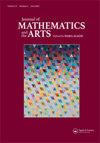Thales series: all the rectangles of the world
IF 0.2
Q4 MATHEMATICS, INTERDISCIPLINARY APPLICATIONS
引用次数: 0
Abstract
In January 2019, I turnedmy interests in art and geometry frommy work with incommensurable ratios and the grids they make to a theorem by Thales of Miletus. Thales observed that in a semi-circle, as AC in Figure 1a, any point, B, on the circumference of that semicircle, AC, when drawn to the ends of the diameter, AC, will always make a ninety-degree angle at that point, B. Because there are an infinite number of points on the circumference of the semi-circle, an infinite number of right triangles can be generated, as in Figure 1b. In Figure 1c, it follows then that in a complete circle, any right triangle, AKM, by rotating it a half-turn about the centre, O, of this circle, will produce a rectangle, AKMZ. This diagram shows one easy way to achieve this rotation a halfturn: draw a line from point K through the centre of the circle, O, to R. Because of the infinite number of points on the circle, an infinite number of rectangles – all the rectangles of the world in fact – can be generated. The result of my studies is a new series of drawings and watercolours entitled, ‘Thales Series: All the Rectangles of the World’ (ATROTW for convenience). When I began my series, I realized that any and all rectangles I drew using thismethod have three common features: (a) They share a common diagonal; (b) This diagonal is equal to the diameter of the generating circle; and, (c) This diagonal is also the hypotenuse of a right triangle. While other construction methods can produce axially-aligned rectangles as well as radial, rotational, and reflection symmetries in the circle, my interests so far have centred on generating specific ratios and families of rectangles into the circle using these three features of Thales’ theorem. I continue to work with the diagonal/diameter/hypotenuse relationship because I like the dynamic and unique appearance of the artworks. I also like the challenges and aesthetic considerations presented in the Thales construction.泰勒斯系列:世界上所有的矩形
2019年1月,我将我对艺术和几何的兴趣从不可通约比率及其网格的工作转向了米利都的泰勒斯定理。泰勒斯观察到,在一个半圆中,如图1a中的AC,在这个半圆的圆周上的任何一点B,当画到直径AC的两端时,总是与该点B成90度角。因为在半圆的圆周上有无限个点,可以生成无限个直角三角形,如图1b所示。在图1c中,可以得出这样的结论:在一个完整的圆中,任何直角三角形AKM,绕这个圆的中心O旋转半圈,将产生一个矩形AKMZ。这张图展示了实现这种旋转的一种简单方法:画一条线,从点K穿过圆的中心,O,到r。因为圆上有无限数量的点,可以生成无限数量的矩形——实际上是世界上所有的矩形。我的研究成果是一个新的绘画和水彩画系列,题为“泰勒斯系列:世界上所有的矩形”(ATROTW为方便)。当我开始我的系列时,我意识到我用这种方法画的任何和所有的矩形都有三个共同的特征:(a)它们有一个共同的对角线;(b)这条对角线等于产生圆的直径;(c)这条对角线也是直角三角形的斜边。虽然其他构造方法可以在圆中产生轴向排列的矩形以及径向、旋转和反射对称,但到目前为止,我的兴趣集中在利用泰勒斯定理的这三个特征在圆中产生特定比例和矩形族。我继续使用对角线/直径/斜边的关系,因为我喜欢艺术作品的动态和独特的外观。我也喜欢泰利斯建筑中呈现的挑战和美学考虑。
本文章由计算机程序翻译,如有差异,请以英文原文为准。
求助全文
约1分钟内获得全文
求助全文
来源期刊

Journal of Mathematics and the Arts
MATHEMATICS, INTERDISCIPLINARY APPLICATIONS-
CiteScore
0.50
自引率
0.00%
发文量
19
 求助内容:
求助内容: 应助结果提醒方式:
应助结果提醒方式:


